更新时间:2024-05-16浏览量:53
Highlight: 1. The current for lithium battery safety test is not comprehensive, this paper through the acupuncture experiment platform, in different SOC, speed, position and depth of experiment, record and analysis of lithium battery in the process of acupuncture load, temperature and voltage parameter changes and its rule, to the existing experimental research on the useful supplement.2. Obtained the force-electric-thermal response and evolution law of lithium batteries under different SOC, different acupuncture speed, depth and position, which provides beneficial value for the transportation, safe use and early warning design of lithium ion batteries.
Power battery is squeezed by sharp objects is the main form of damage caused by automobile collision, is also a very severe working condition, serious lithium ion battery explosion will cause electric vehicle damage or even personal injury. In order to reveal the safety performance of lithium ion battery in acupuncture condition, the work, the use of 5 mm diameter of flat tungsten steel needle into 18650 cylindrical lithium ion battery, discusses the four parameters (charge state, acupuncture speed, acupuncture depth and acupuncture position) on the lithium ion battery safety performance, using infrared camera observation lithium ion battery thermal runaway phenomenon, and record the temperature, open voltage and load before and after the experiment. The experimental results show that the lithium ion battery shows obvious evolution under the acupuncture condition. The lithium ion battery does not have thermal runaway, but there is a certain reaction time; the higher the charge state, the deeper the acupuncture depth, the more likely the thermal runaway and the more near the reaction of the lithium ion battery; there is no obvious correlation between the acupuncture speed and the thermal runaway. Finally, according to the experimental results, it provides suggestions for the transportation, safe use and early warning algorithm design of lithium ion battery packs.
Key words: lithium battery; safety performance; evolution law; thermal runaway
Lithium-ion batteries are widely used in a variety of products, from consumer electronics such as mobile phones and laptops, for their high specific energy, stable performance, low self-discharge rate and green environmental protection, to transport vehicles such as electric vehicles. However, with the widespread use of lithium-ion batteries, their safety problems have become increasingly prominent. In recent years, the safety accidents caused by the thermal runaway of lithium-ion batteries have been frequently reported, most of which are caused by the internal short circuit caused by the sharp objects piercing the battery shell. Therefore, the research and analysis of the safety performance of lithium ion batteries under acupuncture conditions is of great significance for the safety design of protective lithium ion batteries. At present, domestic and foreign researchers have done a lot of research under the working condition of lithium ion battery acupuncture, and have also achieved rich results. Through the combination of experiment and simulation, Wang et al. concluded that the steel needle plays a dual role in the penetration process, which determines the short-circuit current and heat dissipation amount. Liu et al. studied the change of temperature and end voltage of lithium battery in the process of acupuncture. The experimental results showed that the surface temperature of lithium battery with higher initial charge state (state of charge, SOC) increased greatly and had the highest temperature increment in the penetration position. Xu et al. studied the thermal runaway mechanism of soft pack lithium ion battery through multiple sets of acupuncture experiments. The results showed that in the process of acupuncture, the soft pack battery experienced four processes: pinning, internal short circuit, chemical reaction and thermal runaway. Literature [6] conducted acupuncture experiments on three materials of lithium-ion batteries, and the results showed that NMC622 batteries have the worst internal short circuit tolerance, LiFePO4 (LFP) material is less affected by steel needle penetration, and LFP batteries have the lowest risk of thermal runaway when SOC is 50%. Literature [7] conducted the acupuncture experiment on the vehicle LFP battery pack, and by analyzing the experimental data reached the conclusion of whether the acupuncture battery in the parallel battery pack depends on the short circuit resistance value in the battery and the external reverse charging flow. Although the current existing studies have achieved some important research results on the failure analysis of lithium battery under the acupuncture abuse condition, there are still insufficient comprehensive experimental studies on the relevant parameters (SOC, loading speed, position and depth) of 18650 cylindrical lithium ion battery in the acupuncture condition. In this work, the experiment with different SOC, speed, position and depth, record and analyze the changes of the load, temperature and voltage of the lithium battery, in order to evaluate the safety of the lithium ion battery under the condition of mechanical damage and the early warning design of the battery.
1 Experimental introduction
A domestic 18650 cylindrical lithium ion battery was selected, and the parameters of lithium battery are shown in Table 1. The battery test system is used to charge and discharge the lithium battery to the required SOC of the experiment.

The acupuncture experiment platform is shown in Figure 1, where the microcomputer controlled electronic universal testing machine with a range of 100 kN was used to simulate the acupuncture loading process. Use Φ 5 mm and use high precision digital oscilloscope and infrared camera. Given the risk of explosion in needle loading, the battery is placed in a self-made glass box with explosion-proof function.

The experimental methods refer to GB 31241- -2022, Technical Specification for Safety of Lithium-ion Batteries and Battery Packs for Portable Electronic Products, and GB / T 38031- -2020, Safety Requirements for Power Batteries for Electric Vehicles. The experiments considered the influence of four factors, SOC, speed, position and depth, including four sets of experiments, and the parameter settings are shown in Table 2. Figure 2 shows the acupuncture position of the needle in the experimental test, and the three positions are at the top, middle and bottom of the lithium battery. After piercing the battery with a steel needle, observe for 1 h, then the battery is removed to save the current experimental data. After each experiment, hold the temperature for 30 min, check the temperature in the steel needle and the protection box, and conduct the next experiment after returning to room temperature. Furthermore, all experimental conditions used the control variable method to exclude the influence of irrelevant factors. In addition, each group of experiments was repeated at least three times, and one experimental data with good repeatability was taken for study to exclude the chance of the experiment and ensure the accuracy of the experimental data.
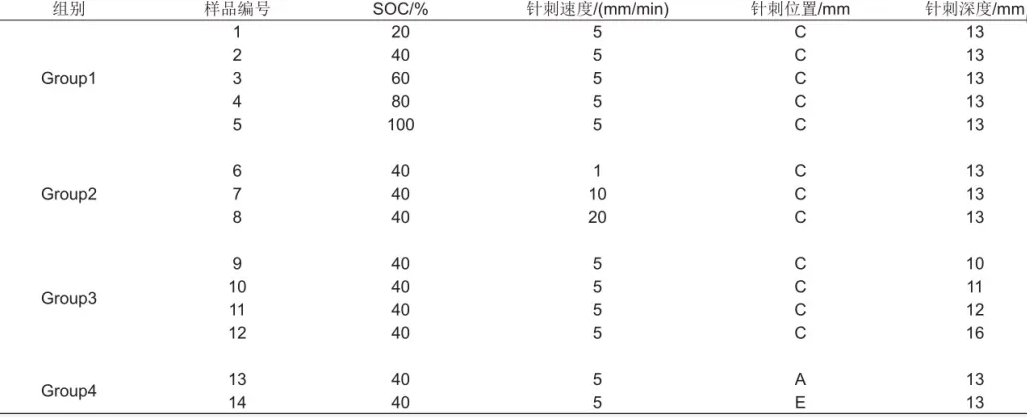
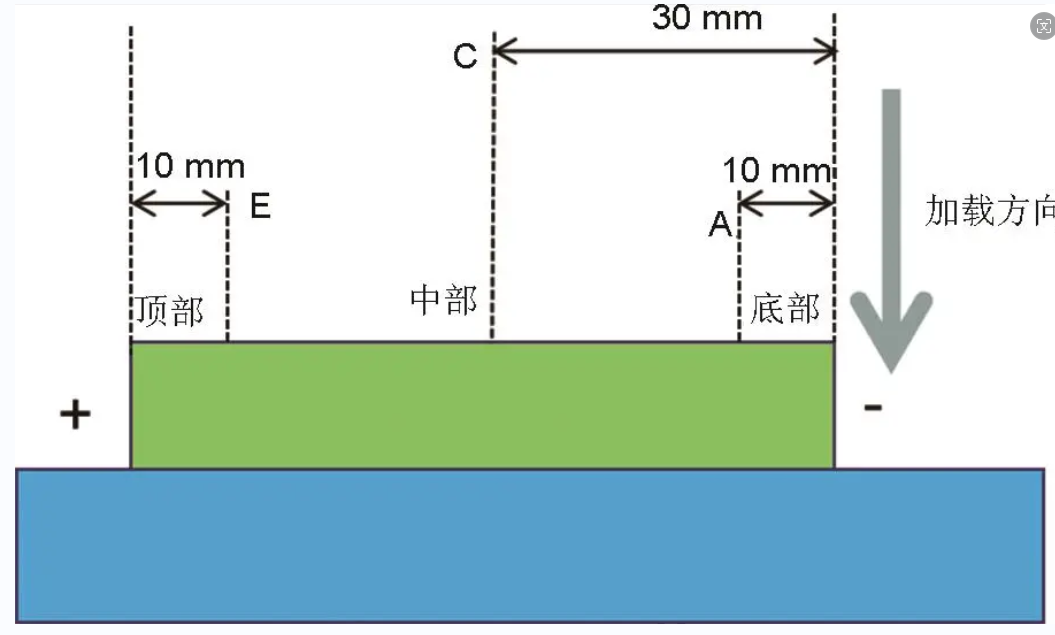
2 Results and analysis of acupuncture experiments
2.1 Analysis of lithium battery characteristics under different charge states
Lithium batteries at 5 states of charge (20%, 40%, 60%, 80% and 100%) were selected for acupuncture experiment. The specific experimental parameters are shown in Table 2 (sample 1~ 5). The limit load and terminal voltage drop time nodes of the lithium battery under different SOC conditions are shown in Table 3. Figure 3 and Figure 4 show the experimental test results of the Group 1 group.

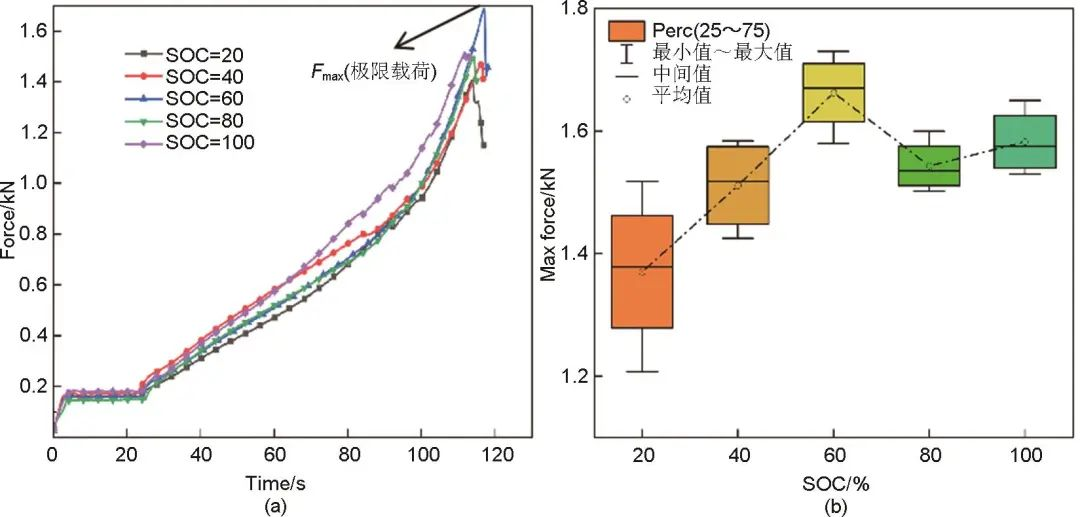
Figure 3 (a) Load-time curve; (b) Box plot of limit load of lithium battery
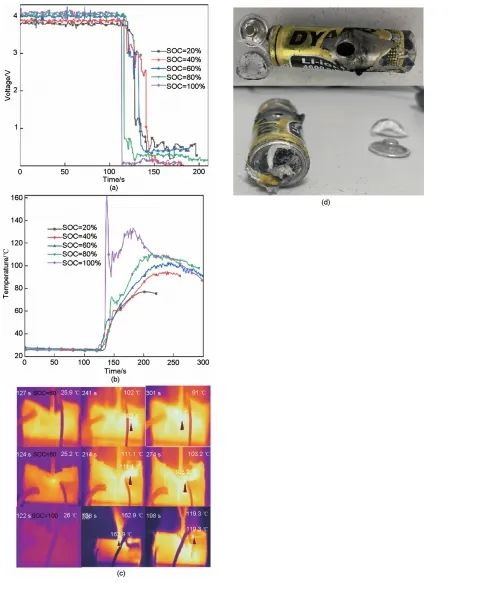
Figure 4 (a) voltage-time curve; (b) temperature-time curve; (c) infrared thermal image; (d) deformation diagram of 100% SOC battery
The load-time curves for different states of charge are shown in Figure 3 (a). The front trend of the curve in the five charge states is roughly the same, first going through a linear growth stage, then entering the slow growth platform area, the bearing capacity changes very little, and then entering the rapid growth stage, showing exponential growth. This is because the lithium battery steel shell and inner core, inner core between each layer plate and diaphragm, and the inner hollow part of the gap, early experimental loading, battery steel shell first began to bear the load, continued loading to a certain extent, then began to squeeze between the core layer and the inner hollow part of the gap. So the load change in the initial stage is very small, and after the internal gap of the battery is compacted, the load increases rapidly. The load generated by the failure of the battery shell is called the ultimate load. It can be seen from Figure 3 (a) that the ultimate load and SOC are not simply a growth relationship, and the corresponding ultimate load is the maximum when the SOC is 60%. The possible reason is that the amount of lithium embedded in cathode materials increases with the increase of SOC, so batteries with 60% SOC have a stronger carrying capacity than batteries below 60% SOC. When SOC is greater than 60%, lithium battery internal active chemical content gradually increased, in the process of acupuncture thermal runaway reaction, from the positive safety valve and needle position overflow a lot of gas cause lithium battery bulge and limited sliding, causing the reaction force reduction, so the change of lithium battery embedded lithium quantity and limited sliding will lead to its limit load drop. In order to exclude experimental contingency, Group1 performed repeated experiments in each state of charge. Figure 3 (b) shows the boxplot of limit load for multiple experiments in different charge states. It can be seen from Figure 3 (b) that the average limit load is not a simple growth relationship with SOC. When SOC is 20%~60%, the average limit load of lithium battery increases with the increase of SOC, and the average limit load of lithium battery with SOC of 60% is greater than 80%. When the SOC is 80%~100%, it also increases with increasing SOC. The maximum average ultimate load is 1.66 kN (SOC = 60%), which is 20% higher than the average ultimate load with a SOC of 20%. Figure 4 (a) shows the voltage time curve of the cells at different SOC. The experimental results show that the battery SOC has a certain influence on its voltage response. Compared with Figure 3 (A) and Table 3, we can see that the time point when the voltage drop at the battery end is highly consistent with the time point when the battery reaches the ultimate load, indicating that the internal short circuit of the battery occurs at the moment of puncture. The voltage of 20% and 40% did not drop to 0 V at the ultimate load drop time node, but showed a fluctuation and then dropped to about 0 V. The reason may be that the chemical reactivity inside the battery decreases under low SOC conditions, and there is no immediate reaction during short circuit. Figure 4 (b), (c) shows the temperature-time curves and partial infrared thermal images under different SOC conditions. After comparison, it can be found that the higher the charge state of the battery, the earlier the temperature rise, and the higher the corresponding peak temperature. On the one hand, the higher the SOC, the greater the corresponding initial voltage. When the steel needle experiences a short circuit in piercing the battery, according to the Joule's law Q= (/ R) t, the higher the voltage, the more joule heat generated, and the faster the heating rate. On the other hand, the high SOC lithium battery has high chemical content, and the steel needle stabbed into the battery short circuit. As shown in Figure 4 (c), the lithium battery experienced thermal runaway. After the deformation of the battery, outflow of the electrolyte from the needle position and a large amount of white smoke came out. In the late loading period, the battery temperature increases rapidly in a short time and is accompanied by the rapid discharge of irritating gas. This is due to the REDOX reaction of the internal active substance and electrolyte and the air after the steel needle punctured the lithium battery shell. Figure 4 (d) is the deformation diagram after acupuncture under SOC 100%. The explosion occurred at about 136s, the positive safety valve was ejected, a large amount of white smoke emerged and the maximum temperature reached 162.9℃ at the moment of explosion. As a large amount of gas overflows from the acupuncture part at the moment of explosion, you can see that the acupuncture part of the battery is severely damaged and bulging.
2.2 Characteristic analysis of lithium battery under different acupuncture speeds
The loading speed was set to 1 mm / min, 5 mm / min, 10 mm / min and 20 mm / min respectively. The specific experimental parameters are shown in Table 2 (sample 2, sample 6 to sample 8). Figure 5 shows the experimental test results of the Group 2 group.
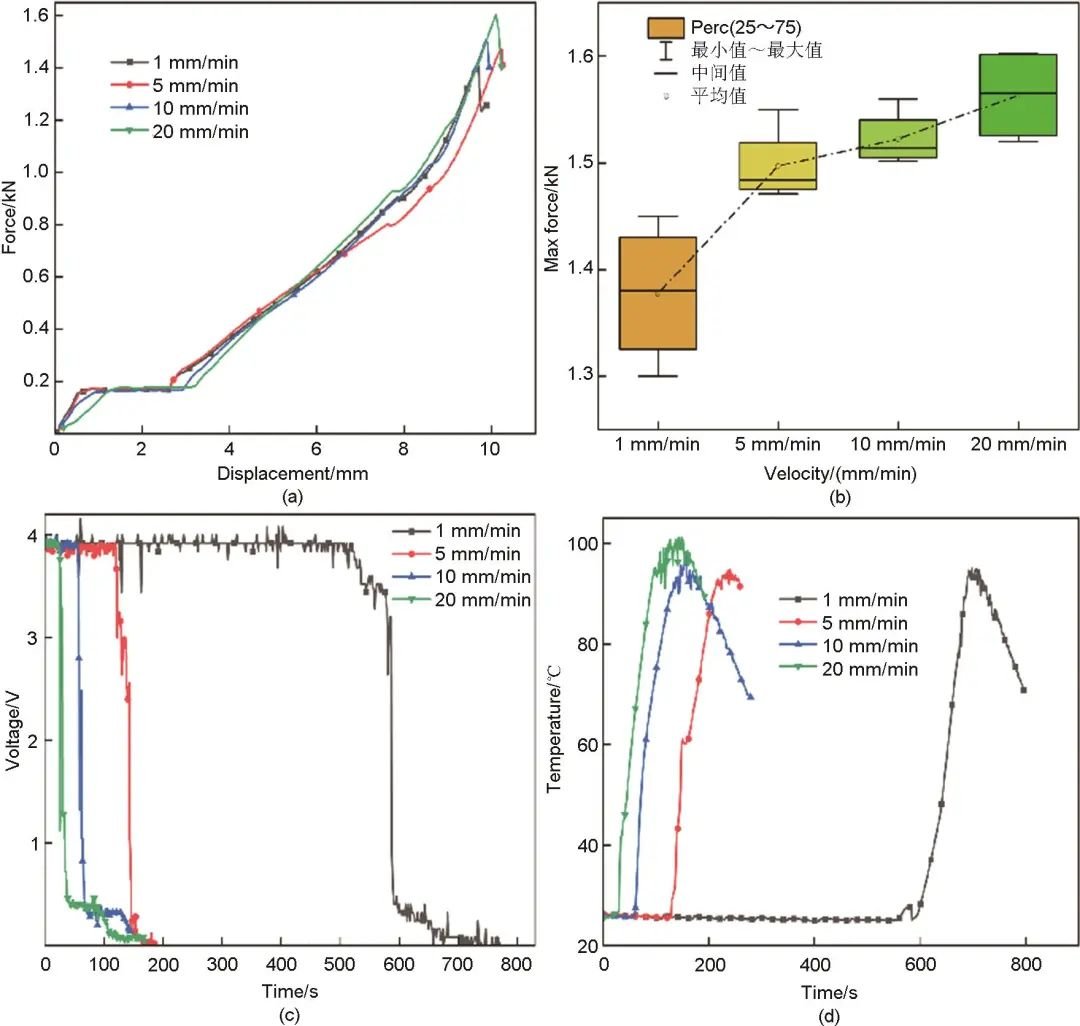
Figure 5 (a) load-displacement curve under different speeds; (b) limit load boxplot; (c) voltage-time curve; (d) temperature-time curve
Figure 5 (a) and (b) show the load displacement curve under different velocity conditions and the boxplot of the battery limit load for multiple experiments under different velocity conditions. It can be seen that the limit load increases with the increasing speed. The maximum average limit load is 1.56 kN (20 mm / min), and the average limit load increases by 14% with the loading speed from 1mm / min sample to 20 mm / min. Group 2 The experimental batteries experienced thermal runaway, and a violent reaction occurred inside the battery, with a large amount of electrolyte flowing out from the needle position and white smoke. As can be seen from the voltage-time curve of Figure 5 (c), with the increase of speed, the time used by the voltage drop is greatly shortened, and the end voltage basically drops to about 0 V. Can be seen from figure 5 (d) four kinds of different speed into the battery battery lifting temperature rate and peak temperature is basically the same, this is because the cylindrical battery positive and negative electrode and diaphragm through the combination of mutual winding into the battery case, diaphragm ductility is poor, in the process of acupuncture puncture diaphragm lead to positive and negative short. The results of Figure 5 (d) show that the speed has little influence on the surface temperature of the selected battery for the work, and the peak temperature is slightly higher when the needle speed is 20 mm / min, reaching 100℃. Under other speed conditions, the peak temperature of the battery surface is basically the same, all are about 95℃, indicating that the energy released by the battery is less affected by the acupuncture speed. This is similar to the conclusions obtained in the literature on [9].
2.3 Characteristic analysis of lithium battery under different acupuncture depths
The increase of the depth of acupuncture will lead to the increase of short circuit electrode site and the increase of contact area, and the probability of direct short circuit will increase, which will be accompanied by a series of side reactions. Therefore, it is of great significance to study the impact of different depths on the safety performance of lithium batteries and to find the critical depth of short circuit. The specific experimental parameter configuration of this work is shown in Table 2 (sample 2, sample 9 to sample 12). Figure 6 shows the experimental test results of the Group 3 group.

Figure 6 (a) voltage-time curve; (b) temperature-time curve; (c) thermal image diagram
Figure 6 (a) for the voltage-time curve, can clearly see when the depth of 10 mm, the voltage did not change, indicating that no short circuit inside the lithium battery, when the depth of 11 mm, voltage in around 124s from 3.9 V to 3.6 V and then slowly rise to 3.78 V and maintained at about 3.78 V, indicating that the battery internal positive and negative electrode has been short cause local short circuit. The reason of voltage recovery is analyzed. When the local heat at the acupuncture site is too high, the local area of the fluid collector, the diaphragm and the puncture point may melt, so the current path will be cut off and hinder the further discharge of the lithium battery. Whether the melting of the diaphragm and the fluid collector will determine whether the voltage drop can be restored. Figure 6 (b) and (c) are the temperature-time curve and thermal images. From Figure 6 (b) and (c), it is clear that the peak temperature of the battery surface increases with the penetration depth. When the depth of acupuncture is 10 mm and 11 mm, the surface temperature of the battery is not high, the degree of chemical reaction inside the battery is not intense, and there is no white smoke and irritating gas, indicating that there is no thermal runaway. When the lithium battery pierced 10 mm, there was no short circuit in the battery, and the temperature was kept at about 25℃. When the acupuncture depth of the needle is 11 mm, the positive and negative electrode materials inside the battery have a slight contact, which triggers a local short circuit, consumes a small amount of energy, and the heating rate is relatively slow. The time from the initial puncture of the battery to the peak battery temperature is about 285s, and the peak surface temperature of the battery is 35℃. When the steel needle was pierced into the depth of 12 mm, 13 mm and 16 mm, the battery experienced thermal runaway, and the irritating gas and white smoke were ejected from the puncture site, and the electrolyte leaked. After piercing the shell, the temperature rose sharply and soon reached the peak. The peak surface temperature of the battery exceeded 90℃. To sum up, when the steel needle stabbed into the lithium battery, there is a critical depth from the local short circuit to the whole internal short circuit of the lithium battery. The critical depth of the lithium battery selected in this work is about 11 mm. When the puncture depth is less than the critical depth, the lithium battery will not undergo thermal runaway, and the battery surface temperature will rise slowly. When the puncture depth is greater than the critical depth, the battery will undergo thermal runaway, and the battery surface temperature will rise sharply.
2.4 Characteristic analysis of lithium battery at different acupuncture positions
Three different positions were selected for the experiments, as shown in Figure 2, and the parameter settings are as shown in Table 2 (sample 2, sample 13 to sample 14). Figures 7 and 8 show the experimental test results of the Group 4 group.
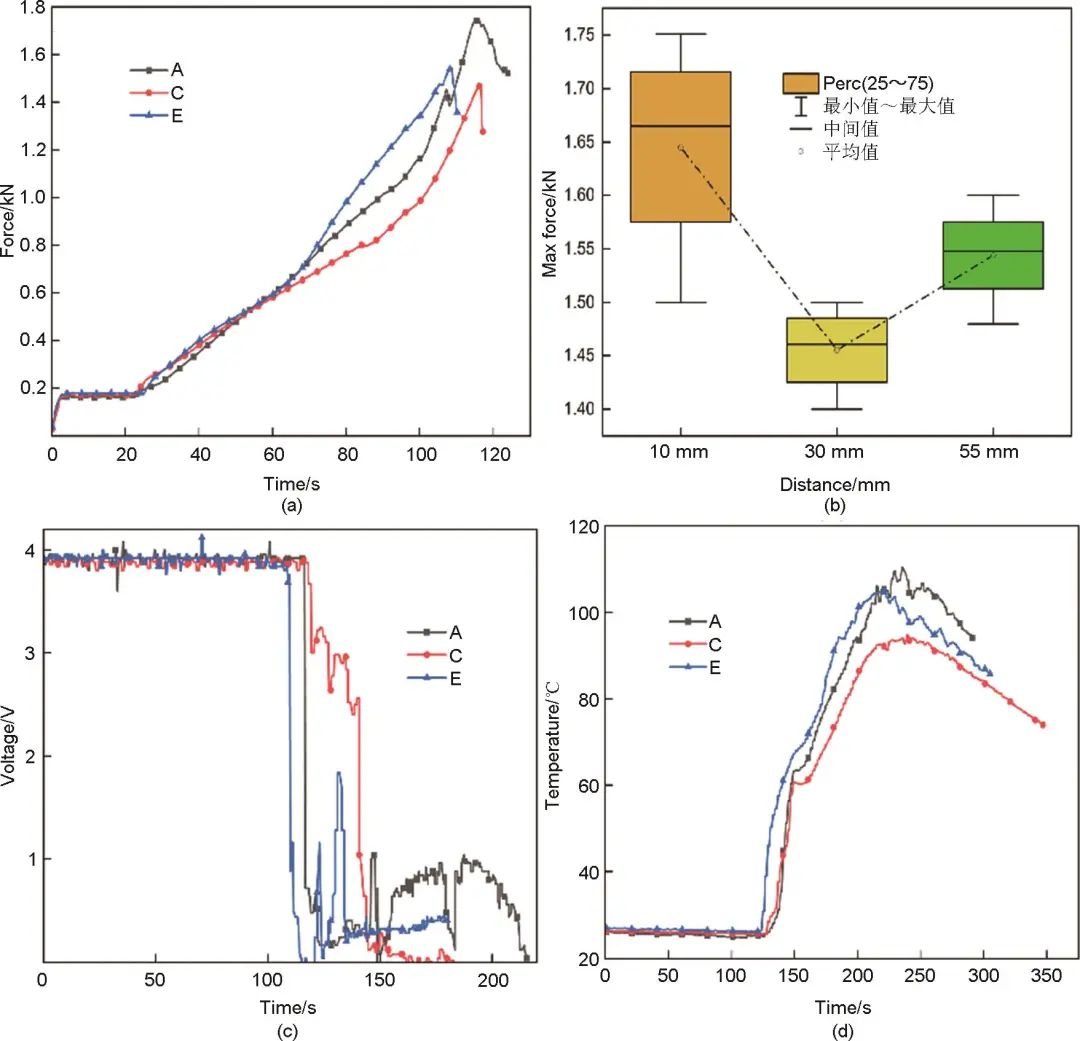
Figure 7 Force-electric-thermal response of lithium battery at different acupuncture positions
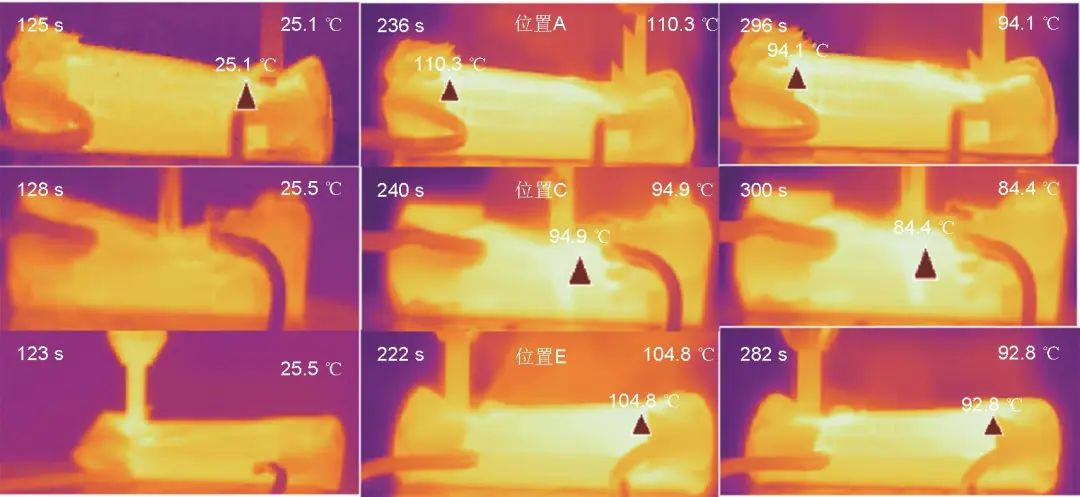
Figure 8 Thermal images at different acupuncture positions
Figure 7 (a) shows the load-time curve of the lithium battery at different positions. It can be seen that different loading positions have a great impact on the carrying capacity of the battery. The closer it is to the positive and negative electrodes of the battery, the greater the ultimate bearing capacity, the greater the rising slope, and the smaller the opposite. Figure 7 (b) shows the boxplot of the battery limit load for multiple experiments at different needle positions. It can be seen from the data distribution in the figure that the influence of the needle position on the battery limit load has an obvious regularity. The closer the needle position is to the axial center of the battery, the smaller the limit load is, and the greater the limit load is. Figure 7 (c) shows the voltage-time curve at different positions. It can be seen from the figure that the first short circuit occurs near the positive pole (E), and the latest one occurs in the middle position (C). The voltage near the positive and negative poles (E and A) did not directly drop to 0 V after falling sharply, but rebounded to higher voltages 1.84 V and 1.1 V, and then began to fluctuate gradually to 0 V. This is because positions A and E are very close to the core end of the battery, and there is A gap between the core end of the lithium battery and the shell. Finite slip and stress concentration will occur in the process of continuous loading, so the voltage will appear temporarily unstable. At the same deformation amount, the local strain at the edge position will be greater, causing the diaphragm to fail easier, and the occurrence of internal short circuit will be earlier. Similarly, under the same deformation amount, the local strain will be smaller when the needle position is close to the middle of the battery, so the internal short circuit will occur later. FIG. 7 (d) and FIG. 8 show the temperature-time curve and infrared thermal image of the battery at different positions. The lithium battery shown in FIG. 8 causes thermal runaway phenomenon (a large amount of electrolyte flows from the acupuncture position and a large amount of white smoke emerges), and the closer the penetration position is to the positive and negative electrodes, the greater the danger of thermal runaway. The closer it is to the positive and negative poles, the faster the battery temperature rises after a short circuit and the higher the peak temperature is. Among them, the peak battery surface temperature at 10 mm (A) and 55 mm (E) from the negative electrode is 110.3℃ and 104.8℃, respectively, and the peak temperature at 30 mm (C) from the negative electrode is 94.9℃. In conclusion, the edge position of the lithium battery selected in this work is more prone to thermal runaway.
3 Conclusion
In this work, a series of experiments on SOC, acupuncture speed, depth and position were conducted on a single 18650 lithium-ion battery. The influence of different parameters on the safety performance of the lithium battery is analyzed by using the force-electric-heat correlation data of the battery, and the following conclusions are drawn.(1) The ultimate load of lithium battery is not simply growing with SOC. When SOC is 20%~60%, the ultimate load increases with increasing SOC; when SOC is 80%~100%, it also increases with the increase of SOC. The maximum average limit load is 1.66 kN, 20% higher than the average limit load of 20% SOC. The larger the SOC, the more intense the reaction of the acupuncture process, and the greater the risk of thermal runaway. For different acupuncture speeds, the surface rise and fall temperature rate of the battery is consistent, the peak temperature is about 95℃, and there is no obvious correlation between the acupuncture speed and whether thermal runaway occurs.(2) In the process of acupuncture, the deeper the penetration, the greater the contact area leading to the short circuit, the greater the risk of combustion and explosion of the battery, and there is a critical depth from the local short circuit to the short circuit in the whole lithium battery. The critical depth of lithium battery selected in this work is about 11 mm, which can be used as the threshold of early warning design to remind users. Different positions have a great impact on the force-electric-heat of lithium battery. When the needle position is close to the positive and negative electrodes, the ultimate load and peak temperature are higher than that in the middle position. The peak temperatures were 104.8℃ and 110.3℃, respectively. When the lithium battery is collided near the positive and negative electrode by external forces, its safety performance is reduced, and the more likely it is to cause thermal runaway and other safety accidents.(3) In view of the thermal runaway of the lithium battery near the positive and negative electrode, it is suggested that the surrounding components of the battery in the battery pack should be arranged as smooth as possible to enhance the thickness and toughness of the lithium battery pack shell. Install the spring buffer device or rubber air cushion at the lithium battery pack near the positive and negative electrode of the battery to avoid the damage to the lithium battery caused by local extrusion. In this work, through the acupuncture experiment platform, we analyzed the force-electric-thermal response and evolution rules under the conditions of SOC, acupuncture speed, depth and position, which provides beneficial value for the transportation, safe use and early warning design of type 18650 lithium-ion battery.
[Dite instrument provides you with battery safety performance testing solution]

Independent developed by the instrument, the battery comprehensive performance laboratory chamber can realize the coupling of a variety of environmental elements (temperature, pressure, atmosphere, etc.), and conduct multiple types of battery tests (acupuncture, extrusion, overcharge, overdischarge, short circuit, temperature cycle, ignition, fire extinguishing), used for the comprehensive performance test of single battery and small battery module.
Contact number: 0551-65186521
Customer service WeChat ID: HeFi-DSYQ